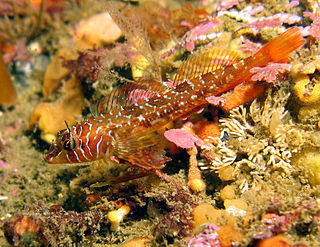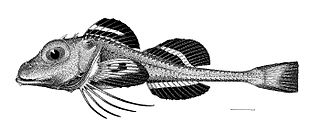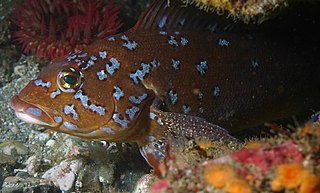
The grunt sculpin or grunt-fish is a small fish mainly found in the eastern Pacific Ocean. The grunt sculpin generally remains close to shore and is often found in empty giant barnacle shells. The common name comes from reports that the fish vibrate or "grunt" when held. Its defining feature is its tendency to “hop” along the ocean floor on its orange fins. The short, stout body of the grunt sculpin has a long, small mouth which is adapted for eating smaller prey.

Rhamphocottidae is a family of ray-finned fishes belonging to the superfamily Cottoidea, the sculpins. The species in this family occur in the North Pacific Ocean.
The mote sculpin, also known as the barehead scorpionfish, is a ray-finned fish, the only member of the monotypic genus Normanichthys, family Normanichthyidae and suborder Normanichthyiodei. Common names for the species in Spanish include camotillo and bacaladillo.

The rock greenling is a species of marine ray-finned fish belonging to the family Hexagrammidae, the greenlings. It is sometimes known as fringed greenling and erroneously as the red rock trout.

Ericandersonia is a monospecific genus belonging to the family Zoarcidae, the eelpouts. It’s only species is Ericandersonia sagamia, a deepwater fish in the family Zoarcidae. The genus and species were newly described in 2006. It was found in Sagami Bay, Japan, at depths of between 880 and 930 m. The genus name honours the South African based American ichthyologist M. Eric Anderson in recognition of his eelpout studies.

Zaniolepis, the combfishes, is a genus of marine ray-finned fish, it is one of two genera in the family Zaniolepididae. These fishes are native to the eastern Pacific Ocean. Z. frenata that was a source of food to the Native American inhabitants of San Nicolas Island off the coast of southern California, United States during the Middle Holocene.

The longfin sculpin is a species of marine ray-finned fish belonging to the family Jordaniidae, a small family of sculpins. This species is found in the northeastern Pacific Ocean. This species is the only known member of its genus, Jordania.

Ereunias is a monospecific genus of marine ray-finned fish belonging to the family Rhamphocottidae, the grunt sculpins. Its only species is Ereunias grallator which is a bathydemersal species found at depths of around 500 m (1,600 ft) in the northwestern Pacific Ocean off Japan. This species attains a maximum published total length of 30 cm (12 in). This species was first formally described in 1901 by the American ichthyologists David Starr Jordan and John Otterbein Snyder from Misaki, Sagami in Japan. Jordan and Snyder proposed the new genus Ereunias for the new species. The genus name is derived from ereunao, meaning "to explore" which may refer how it uses elongated pectoral-fin rays as feelers or “feet” to explore the substrate; suffixed with ias which is used in some Greek names for fishes. The specific name grallator is "stiltwalker" in Latin and is an allusion to the elongated pectoral fin rays. Along with the genus Marukawichthys this taxon was classified in the family Ereunidae but this was synonymised with the Rhamphocottidae in 2014.

Hexagrammos is a genus of marine ray-finned fishes belonging to the family Hexagrammidae, the greenlings. These fishes are found in the north Pacific Ocean.

The marbled spinefish, also known as the yellow waspfish, is a species of ray-finned fish, a waspfish belonging to the subfamily Tetraroginae of the family Scorpaenidae, the scorpionfishes and their relatives. It is the only species in the monotypic genus Cottapistus. This species is found in the Indo-West Pacific.

The Northern ronquil is species of marine ray-finned fish belonging to the family Bathymasteridae, the ronquils. This species is found in the eastern Pacific Ocean. This species is the only known member of its genus.
Helen K. Larson is an ichthyologist who specialises in the fishes of the Indo-Pacific.
Stichaeopsis is a genus of marine ray-finned fishes belonging to the family Stichaeidae, the pricklebacks or shannies. These fishes are found in the western North Pacific Ocean.
Askoldia is a monotypic genus of marine ray-finned fishes belonging to the family Stichaeidae, the pricklebacks and shannies. Its only species is Askoldia variegata which is found in the northwestern Pacific Ocean.

Davidijordania is a genus of marine ray-finned fishes belonging to the family Zoarcidae, the eelpouts. The fishes in this genus are found in the northwestern Pacific Ocean.
Nalbanichthys is a monospecific genus belonging to the family Zoarcidae, the eelpouts. It’s only species is Nalbanichthys elongatus which is found in the southern Bering Sea. The genus name honours the Romanian ichthyologist Theodor Nalbant who sent specimens to Leonard Peter Schultz for him to describe.
Bentartia is a genus of marine ray-finned fish belonging to the family Zoarcidae, the eelpouts. Some authorities treat this genus as monospecific, with the only species being Bentartia cinerea of the Southern Ocean, but other authorities include 4 species from the eastern Pacific Ocean.
The cuskpout is a species of marine ray-finned fish belonging to the family Zoarcidae, the eelpouts. It is the only species in the monospecific genus Derepodichthys and is found in the eastern North Pacific Ocean.
The bearded eelpout is a species of marine ray-finned fish belonging to the family Zoarcidae, the eelpouts. This species is the only species in the monospecific genus Lyconema. It is found in the eastern Pacific Ocean.

Jordaniidae is a small family of marine ray-finned fishes belonging to the order Scorpaeniformes. These fishes are found in the eastern North Pacific Ocean.









